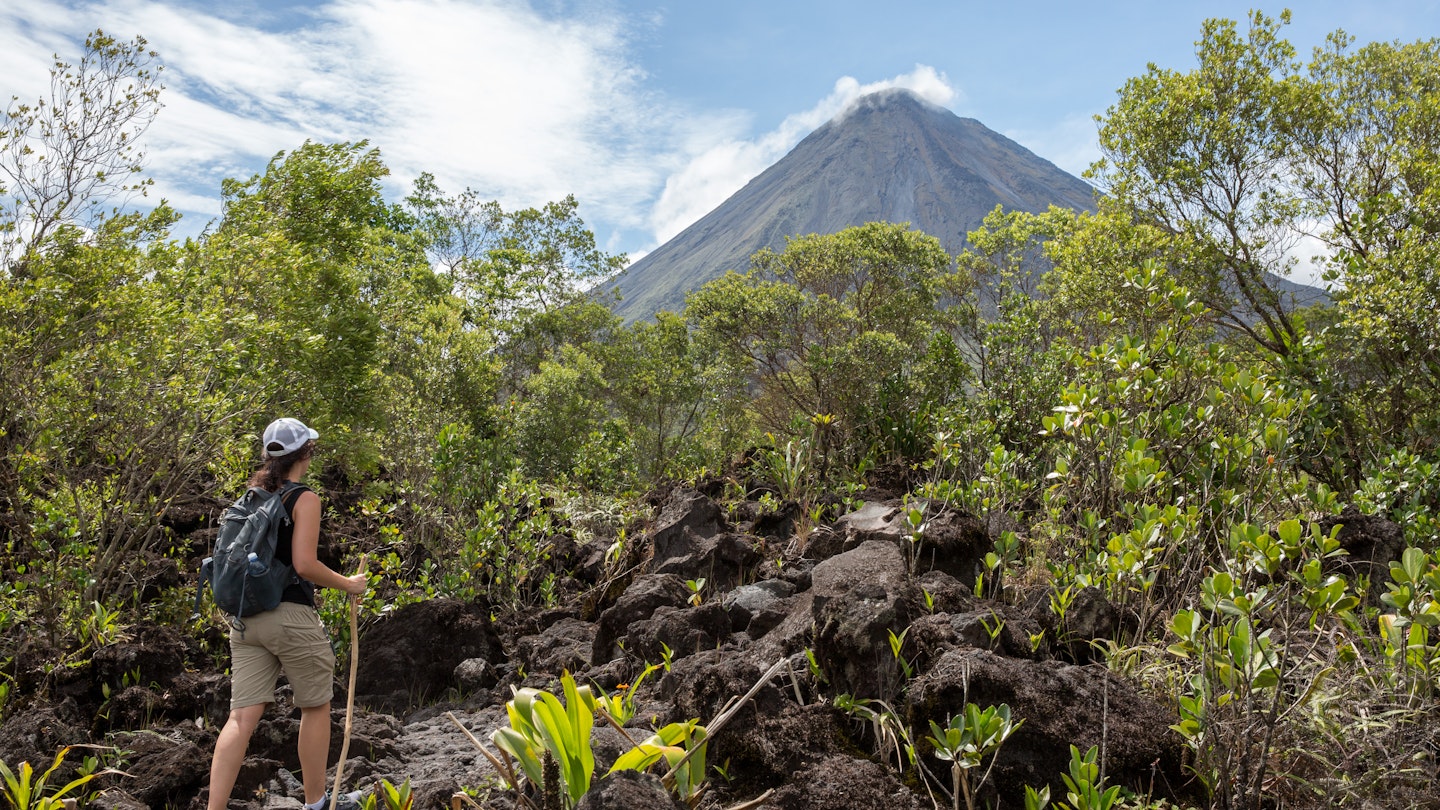From grumpy volcanoes to labyrinthine limestone caves and stunning black-sand beaches, offers a never-ending array of natural wonders that keep visitors coming back. Here are 10 natural wonders that make this gem one of the most popular destinations in the world.
Parque Nacional Volcán Arenal
From 1968 until 2010, was an ever-active and awe-striking natural wonder, producing menacing ash columns, massive explosions, and streams of glowing molten rock almost daily. While the fiery night views are gone for now, this mighty mountain is still a worthy destination. Part of the Área de Conservación Arenal, the park is rugged and varied, with about 15 km (9.3 mi) of well-marked trails that follow old lava flows. Hikers routinely spot sloths, coatis, howler monkeys, white-faced capuchins, and even anteaters.
Parque Nacional Tortuguero
Canoeing the canals of Parque Nacional Tortuguero offers a boat-borne safari experience. Here, thick jungle meets the water and you can get up close with shy caimans, river turtles, crowned night herons, monkeys, and sloths. In the right season, under cover of darkness, you can witness the awe-inspiring ritual of turtles building nests and laying their eggs on the black-sand beaches. Sandwiched between extravagantly green wetlands and the wild Caribbean Sea, this is among the premier places in Costa Rica to watch wildlife.

Monteverde Cloud Forest
This pristine forest is famous for its misty atmosphere, moss-covered vines, and diverse plant life, including ferns and bromeliads. Reserva Biológica Bosque Nuboso Monteverde was established in 1972, when the local Quaker community banded together with environmental organizations to preserve 328 hectares (811 acres) of land. Today, this ecological sanctuary spans 41.25 sq km (26,400 acres), allowing a maximum of 250 visitors at any given time. To fully enjoy the experience, arrive before gates open or visit during the off-seasons (usually May through June, and September through November). Opting for a night tour or staying overnight in one of the lodges greatly increases your chances of spotting wildlife.
Cerro Chirripó
The view from the rugged peak of Cerro Chirripó, the country’s highest summit, may not resemble the Costa Rica of postcards, but the two-day hike above the clouds is among the most rewarding excursions in the nation. A pre-dawn expedition grants hardy hikers the opportunity to witness a breathtaking sunrise and see both the Caribbean Sea and the Pacific Ocean in a glorious panorama from 3820 m (12532 ft) up. The only way to reach Chirripó is by foot. Although the trekking routes are challenging, the experience is immensely fulfilling.
Parque Nacional Chirripó provides a refreshing escape from the lowland heat. Above 3400 m (11155 ft), the landscape features páramo, which includes scrubby trees and grasslands. Rocky outcrops punctuate the otherwise spare hills and feed a series of glacial lakes that earned the park its iconic name: Chirripó translates to “Eternal Waters.”

Playa Negra
At the northwestern end of , Playa Negra is a long black-sand beach that proudly flies the bandera azul ecológica, a flag signifying that the beach is maintained to the highest ecological standards. This location is undoubtedly Cahuita’s top spot for swimming and remains uncrowded. When swells are substantial, Playa Negra also provides excellent beach breaks for beginner surfers.
Venado Caves
Located two kilometers (1.2 miles) northeast of Venado, these caves offer an adventurous excursion into an eight-chamber limestone labyrinth that extends for nearly 3 km (1.86 miles). A bilingual guide leads small groups (limited to seven) on two-hour tours through the darkness, navigating narrow passages while highlighting fascinating rock formations. A combination of rubber boots, headlamps, helmets, and a hot shower after the tour ensures a safe and enjoyable visit.

Parque Nacional Manuel Antonio
Although droves of visitors flock to Parque Nacional Manuel Antonio, which is the country’s most popular and smallest national park, it continues to be a treasured destination. Capuchin monkeys scurry across its picturesque beaches, while brown pelicans dive into the crystal-clear waters. Sloths can be seen overseeing the accessible trails, creating a perfect setting to introduce visitors, especially youngsters, to the delights of the rainforest. Yoga by the beach feels like a dream, and even with its popularity, the park’s beauty makes up for the crowds.
Parque Nacional Barra Honda Caverns
This 23 sq km (247 acres) national park safeguards a network of 42 caverns. The only cave with regular public access is the 41 m-deep (135 ft) La Terciopelo, notable for its stunning speleothems (calcite formations that rise and fall throughout the cave). It resembles an underground art gallery, featuring stalagmites, stalactites, and formations dubbed fried eggs, organ, soda straws, flowers, and shark teeth. To experience this marvel, contact the ranger station at least one day in advance to arrange the four-hour guided tour.

Parque Nacional Volcán Poás
Located just 37 km (23 miles) north of Alajuela, along a winding and picturesque road, Parque Nacional Volcán Poás boasts an impressive 2708 m-high (8885 ft) active volcano. Violent eruptions have not occurred for more than 60 years, but rumblings began in 2014, leading to further significant eruptions in April and June 2017. The park reopened in August 2018, allowing visitors to peer into the 260 m-deep (853 ft) crater and observe a beautiful turquoise lake at its center. Visitors can witness the steaming cauldron belching sulfurous gases, yet hiking trails remain off-limits and visits are confined to 20 minutes at the crater. Consequently, advance reservations are essential to secure your place.
Viento Fresco
If you’re traveling between and , don’t miss out on Viento Fresco. This series of five breathtaking cascades, including the spectacular Arco Iris (Rainbow Falls), plunges 75 m (246 ft) into a refreshing pool ideal for swimming. With minimal crowds, you can fully immerse yourself in the natural beauty of this location, especially if you visit early in the day. The 1.3 km (0.80 miles) of trails are well-maintained, but the stone steps can be slippery after rainfall, making it suitable only for reasonably fit individuals to hike to the bottom and back.




